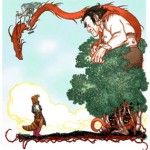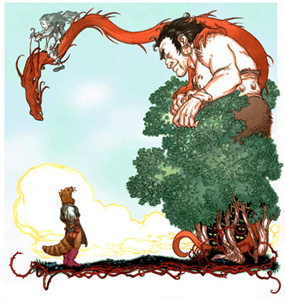 Not unlike “the hour” of which Jesus spoke to the woman at the well, the start of another academic year “cometh, and now is” (John 4.23, KJV). Whether the first school bells near you ring just before or just after Labor Day, you may be looking for a gift to inspire your child or grandchild, brother or sister or nephew or niece, or favorite kid next door as they head back to school. Or, if you are a student facing the start of a new academic term with even less enthusiasm than the Pevensie siblings at the beginning of Prince Caspian, you may be seeking inspiration for yourself!
Not unlike “the hour” of which Jesus spoke to the woman at the well, the start of another academic year “cometh, and now is” (John 4.23, KJV). Whether the first school bells near you ring just before or just after Labor Day, you may be looking for a gift to inspire your child or grandchild, brother or sister or nephew or niece, or favorite kid next door as they head back to school. Or, if you are a student facing the start of a new academic term with even less enthusiasm than the Pevensie siblings at the beginning of Prince Caspian, you may be seeking inspiration for yourself!
Let me recommend a small, lovely volume—subversively shelved, at least in my local Barnes & Noble, as a “children’s book”—called Instructions (Harper, 2010). Award-winning fantasy illustrator and comic book artist Charles Vess has conjured charming paintings (often reminiscent of Arthur Rackham and Kay Nielsen) to illustrate Neil Gaiman’s previously published poem (it first appeared in A Wolf at the Door, Simon & Schuster, 2000). If you enjoyed Dr. Seuss’ Oh, the Places You’ll Go! (Random House, 1990) the first time you read it, but now find its “98 and three-quarters percent” guarantee of moving mountains overly familiar, locate and linger over a copy of Gaiman and Vess’ collaboration.
As a reader of this site, you likely already know—unless you’ve been stuck on a malevolent living planetoid in a pocket universe—that Gaiman, author of multiple genre landmarks and highlights, has earned unimpeachable credibility as a guide through imaginary landscapes. In these pages, his voice rings with authority as he economically evokes classic motifs of myth, tropes of folklore, and archetypes from our collective unconscious. Consider, for instance, these lines: “Beneath a twisted oak sits an old woman. She may ask for something; give it to her. She will point the way to the castle.” I find that passage both matter-of-fact and mesmerizing. Vess enhances the effect with his painting of a world-weary crone, as gnarled as the tree branches under which she sits, directing the gaze of the book’s protagonist—a literally bright-eyed and bushy-tailed young fox—to his next destination.
The narrative voice is at times cryptic (“You may pick strawberries in December’s frost”) and occasionally comic (“The river can be crossed by the ferry. The ferryman will take you. The answer to his question is this: If he hands the oar to his passenger, he will be free to leave the boat. Only tell him this from a safe distance.”) But it is also, unmistakably, the voice of a friend. Look at the page on which we are warned about the “deep well” that leads to “Winter’s realm.” Vess illustrates that kingdom as a pristine but cold modern city of skyscrapers and brownstone tenements. In other words, “Winter’s realm” is our workaday world. And because we have by this point spent several pages in Gaiman and Vess’ fairyland, our world is suddenly exposed as less real and more dangerous than anything the Brothers Grimm could record or J.R.R. Tolkien could “subcreate.” Our narrating friend pauses to let us know we have a choice: “If you turn around here, you can walk back, safely; you will lose no face. I will think no less of you.” The decision is important, but more important is the presence of this guide, this companion, this one who comes to us along our way. We know we will be safe with this voice to talk us through our journey.
I suppose it unlikely Gaiman intended his readers to connect the giver of these Instructions with Jesus. But, being a sci-fi Christian, how can I resist? Particularly when some of the advice seems almost biblical not only in cadence but also in content. “Ride the wise eagle (you shall not fall). Ride the silver fish (you will not drown)” makes me think of God’s promises to Israel in Isaiah 43.2. And what do you think of these admonitions? “If any creature tells you that it hungers, feed it. If it tells you that it is dirty, clean it. If it cries to you that it hurts, if you can, ease its pain.” I think that when we do those things for the least “creature,” we do it for Christ (Matt. 25.40).
In any case, Gaiman and Vess’ lessons are the kind of lessons I’d like the young travelers I know to learn. It wouldn’t hurt me to learn them better, myself. The poem does not spell out its meaning, leaving us free to connect these otherworldly scenarios with what confronts us in “Winter’s realm.” Above all, Instructions seems a plea to be true to one’s self, to be a person of integrity. “Remember your name,” it urges. “Trust your heart, and trust your story.”


Great review, Mike! Wonderful job finding the correlations between the poem and the Bible. I will be sure to check it out next time I am in B&N.
Nice subtle Doctor who reference:) I’ll definitely look for this book.
@ Palindrome – Thanks! But I’m not so sure how subtle it was of me to single out my Doctor Who reference with an active hyperlink to the BBC. 😉
@Max – I do hope you will. It’s a lovely little book all around, and it (together with “The Doctor’s Wife”!) is inspiring me to check out some more of Gaiman’s work.